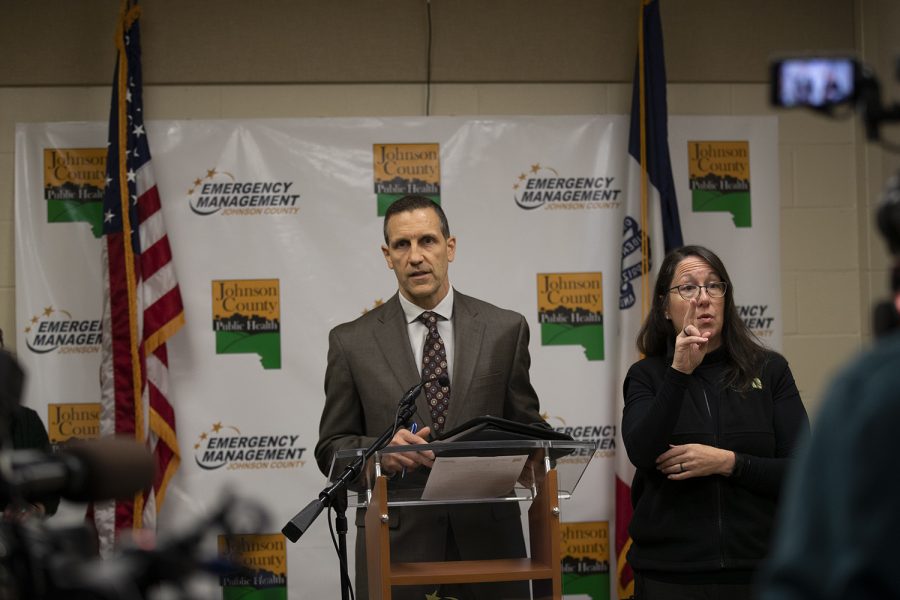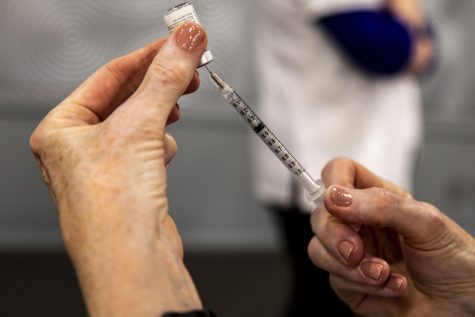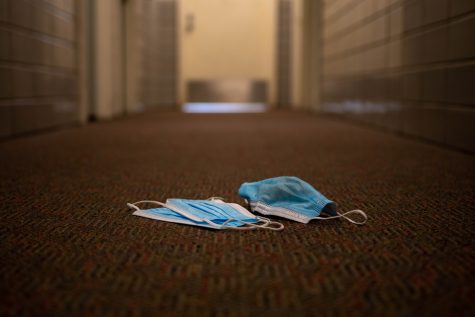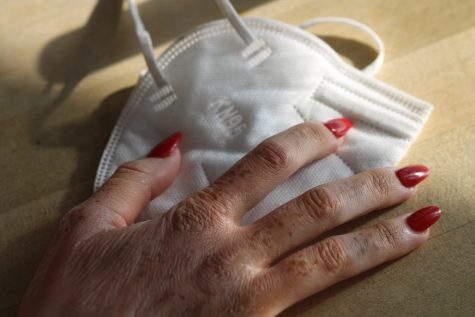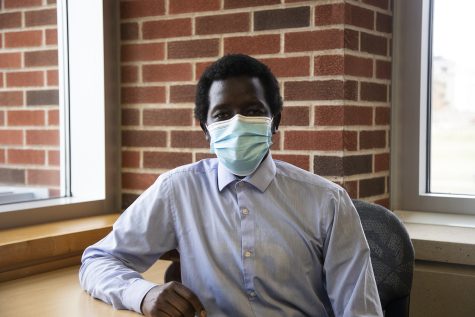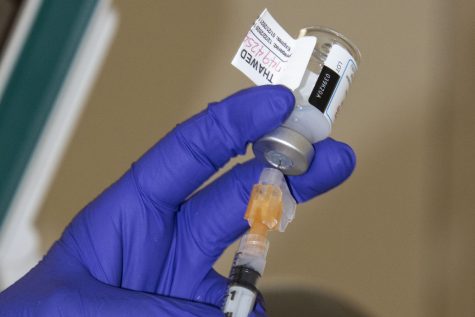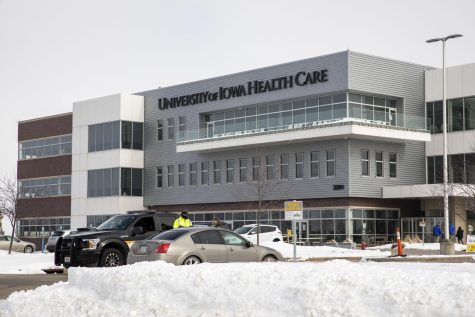Johnson County officials say Iowa’s COVID-19 mitigation memo one ‘tool’
As the debate over whether a shelter-in-place order is needed in Iowa continues, Johnson County officials described a memo with guidance on declaring that order as only one tool in responding to the pandemic.
Johnson County Public Health Director Dave Koch speaks during a press conference about COVID-19 at the Joint Emergency Communications Center on Thursday, March 12, 2020.
April 3, 2020
Johnson County officials on April 3 downplayed the role of the Iowa Department of Public Health’s guidance on implementing COVID-19 mitigation measures including a shelter-in-place order, describing the memo containing those metrics as one of several “tools” for government officials to use in responding to the disease’s spread.
The memo outlines a 12-point system state officials are using to determine whether a shelter-in-place order would be necessary. The guidance considers the percentage of the population over age 65, the percent of identified cases requiring hospitalization, the number of cases in the last 14 days per 100,000 people, and outbreaks at long-term care facilities.
“… That’s a tool to be able to help guide and drive decisions,” Johnson County Public Health Director Dave Koch said at an April 3 news conference. “There’s many other factors that the governor takes into account before issuing any kinds of closures that she has been, and she’s been very clear about that. I think we all want to make decisions based off data. And that’s what those metrics help to do.”
The Press-Citizen first reported on the memo April 1, days after the Johnson County Board of Supervisors sent a letter to Iowa Gov. Kim Reynolds urging her to order Iowans shelter in place or delegate local governments the legal authority to do so.
RELATED: Johnson County Board of Supervisors, Board of Public Health discuss local response to COVID-19
Koch said he did not think the Johnson County Department of Public Health was in a role to ask the state to reassess its metrics but added that communication occurs daily with the Iowa Department of Public Health. The state department would issue guidance locally on whether to implement a shelter-in-place order, he said.
The state’s system decides whether to call for shelter in place based on its division of the state into six regions for hospitals to better coordinate the flow of patients if individuals may need to go to another area for health care. If those four metrics are assigned values that collectively add up to 10 or more, a shelter in place would be advised, according to the guidelines.
Although the system is broken up by region, Koch said his department doesn’t receive information about COVID-19 hospitalizations from the hospitals, which is one of the metrics used in the state’s system, but he said there are currently no Johnson County nursing home outbreaks.
In response to a question about whether a shelter-in-place order would encourage stronger public adherence to social distancing, Koch said, “I don’t know if that would change our objectives at this point right now.”
Leaders from the area hospitals, the University of Iowa Hospitals and Clinics and Mercy Hospital, have cautioned against implementing such a measure, saying they fear the impact that would have on the supply chain needed to provide personal protective equipment to health-care workers.
UIHC Chief Medical Officer Theresa Brennan said April 3 UI Health Care leaders have not changed their recommendation.
“I would say that shelter in place is, of course, a legal decision, a governmental decision,” she said. “[UI Vice President for Medical Affairs Brooks] Jackson had given an opinion regarding the supply chain, which of course we need to continue to get supplies so that we can take care of COVID-19 patients and our other patients.”
Mercy Hospital public-information officer Margaret Reese on April 3 said of a shelter-in-place order, “I think that we have many providers who would feel that that’s a safe thing to do, but obviously we’re going to follow the direction of the governor and Iowa Department of Public Health.”
RELATED: UI Health Care, Mercy leaders urge against shelter-in-place order for now
Johnson County Emergency Management Director Dave Wilson said current mitigation strategies are protecting the most vulnerable citizens — those with preexisting health conditions or the elderly who are more susceptible to falling severely ill or dying from COVID-19.
“There’s a lot of talk about metrics and shelter in place, all those things,” he said. “The effect is that we decide what’s going to go on. We have personal responsibility — as Iowans, as Johnson County folks — regardless of what an order is or what metrics are used, we have a responsibility to not come to work and spread germs… That’s your personal responsibility. I don’t need a law to tell me that and I don’t need an order to shelter in place to tell me that.”
Critics fear that government officials are under-reacting or will react too late to implement measures such as shelter in place based on incomplete data, but Wilson said officials are focused on the information they do know.
The U.S. has reported a lack of widespread testing for those suspected of having COVID-19 and the Food and Drug Administration just April 2 approved the first antibody test to determine whether individuals have recovered and are immune from the disease caused by the novel coronavirus. Without expanding testing, experts say they cannot know the full scope of the virus’ spread.
“There’s a lot of data coming at us and a lot of tools, and those tools that you guys have referenced are just that — they’re the metrics and the tools that the state Department of Public Health looks at,” Wilson said. “… There’s only so many tests available, right, and so we know that there’s a lot of folks out there that could have it that haven’t been tested. We’re trying to plan for the known and what we have right now and look ahead to what could be.”
Asked about how public-health officials reconcile the differences in the supervisors’ and the governor’s recommendations, Wilson said he supports Reynolds’ “stair-step approach” to ordering closures of businesses and schools and banning large gatherings within the state in an incremental manner, commending her decisions as logical and methodical.
“The political leaders have their perspective on things and they’ve listened to all of us, and nobody’s told them not to send that,” he said of the letter the supervisors sent to Reynolds asking for a statewide shelter-in-place order or requesting she delegate the power to make such a declaration. “You know, nobody’s — everybody’s trying to do the right thing.”
RELATED: Reynolds remains fixed against shelter-in-place order
He again urged people to practice social responsibility in following public-health recommendations regardless of the mandate from the state.
“Now, they might have different perspectives on how to get that done,” he said of the governor’s and supervisors’ split opinions, “but I’m not sure what the outcome will be if you issued a shelter in place.”
National Institute of Allergy and Infectious Diseases Director Anthony Fauci, the nation’s leading expert on infectious diseases, has said he didn’t understand why every state hadn’t issued a shelter-in-place order.
Reynolds on April 3 questioned his statement and said, “Maybe he doesn’t have all the information.”
She said he may not be aware that in Iowa, she’s taken steps to accomplish much of what could be accomplished with a shelter-in-place order through the incremental steps she’s taken. She said through the state’s data, officials can determine whether they need to dial up or dial down mitigation efforts within a certain region to eventually reopen businesses while avoiding overwhelming the health-care system.
“What matters is the substance of the order, not the name,” she said.



